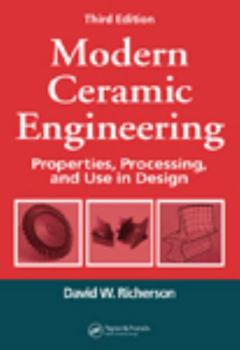Modern Ceramic Engineering: Properties, Processing, and Use in Design, 3rd Edition
Select Format
Select Condition 
Book Overview
Ceramic materials have proven increasingly important in industry and in the fields of electronics, communications, optics, transportation, medicine, energy conversion and pollution control, aerospace, construction, and recreation. Professionals in these fields often require an improved understanding of the specific ceramics materials they are using. Modern Ceramic Engineering, Third Edition helps provide this by introducing the interrelationships between the structure, properties, processing, design concepts, and applications of advanced ceramics. This student-friendly textbook effectively links fundamentals and fabrication requirements to a wide range of interesting engineering application examples. A follow-up to our best-selling second edition, the new edition now includes the latest and most important technological advances in the field. The author emphasizes how ceramics differ from metals and organics and encourages the application of this knowledge for optimal materials selection and design. New topics discuss the definition of ceramics, the combinations of properties fulfilled by ceramics, the evolution of ceramics applications, and their importance in modern civilization. A new chapter provides a well-illustrated review of the latest applications using ceramics and discusses the design requirements that the ceramics must satisfy for each application. The book also updates its chapter on ceramic matrix composites and adds a new section on statistical process control to the chapter on quality assurance. Modern Ceramic Engineering, Third Edition offers a complete and authoritative introduction and reference to the definition, history, structure, processing, and design of ceramics for students and engineers using ceramics in a wide array of industries.
Format:Hardcover
Language:English
ISBN:1574446932
ISBN13:9781574446937
Release Date:November 2005
Publisher:CRC Press
Length:707 Pages
Weight:3.10 lbs.
Dimensions:10.0" x 1.5" x 7.0"
Customer Reviews
4 ratings
Well written for a text book!
Published by Thriftbooks.com User , 16 years ago
I am taking an Intro to Ceramics course; this is the book we use. The book is actually really interesting. The author sometimes even sounds tongue-in-cheek about things! The subject matter ranges over a wide array of manufacturing processes, quality assurance, and material properties. He also throws in a lot of information about phase diagrams and grain structure/growth. I myself am not a materials engineer, but I found the book engrossing (very strange for me!). I did the study guide questions, which I thought were very well written, and the questions at the end of the text. Two drawbacks only: 1) no answers to the study guide questions/back of the chapter questions, and 2) all the pictures are in black and white.
Modern Ceramic Engineering
Published by Thriftbooks.com User , 17 years ago
This book is definetely one of the best in Ceramic Science and Engineering. It serves the very best the interest of students, academics and profecionals from a vast variety of disciplines who is working or starts working or somehow has an interest with ceramic materials. It initiates with the very basics from atomic bonding and crystalline structures, and then proceeds with processing, materials properties and performances, service life predictions, and failure analysis and mechanisms in an interconnected manner. The language is simple to follow, and the case studies are very well selected to fully understand the applications of each individual matters examined in the respective chapters.
Richerson knows a lot about ceramics
Published by Thriftbooks.com User , 18 years ago
This is a pretty good introductory book to Ceramics. There are a few typos in this 3rd edition book, but that doesn't distract from the main flow of it all. There are Review questions at the end of each chapter which are supposed to help one think about what s/he just read. Sometimes, the answer doesn't really come until the next chapter, though. The Author has a good voice in his writing--it's not totally technical jargon. So overall, good book.
Best among currently available Ceramic Engineering Textbooks
Published by Thriftbooks.com User , 19 years ago
I am offering my comments in my capacity as a course instructor. The reason why I recommend this book to my students is because it gives an excellent understanding of industrial applications of ceramic materials. The author has done a great job putting together his industrial experience. Most of the textbooks are written by university professors, who are sometimes ignorant about the industrial practices. This is more true in the rapidly changing field of materials science and engineering in general, and ceramics in particular. After having gone through all the ceramics related books that are currently available in the market, I feel Modern Ceramic Engineering (Materials Engineering) by David Richerson is the best option as a ceramic engineering textbook. The only drawback of this book is that it lacks smooth flow of ideas. Author could generate more interest among the readers by providing more schematics and by avoiding the paragraphs with cluttered information.






